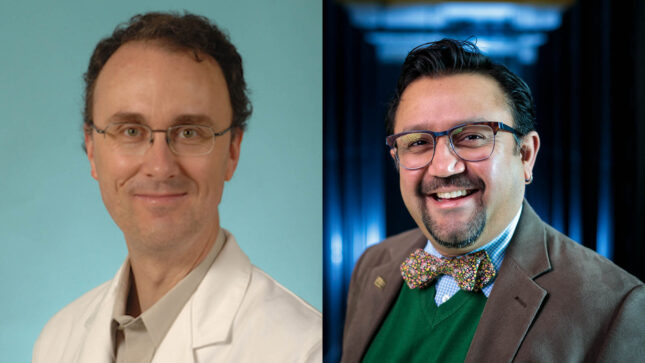
The Department of Pathology and Immunology at Washington University in St. Louis is proud to announce that two of our faculty members, Joseph Corbo, MD, PhD and Gautam Dantas, PhD have played significant roles in the groundbreaking research that contributed to this year’s Nobel Prize recipients in Physiology or Medicine and Chemistry.
Joseph Corbo’s Collaboration with Gary Ruvkun
Joseph Corbo, MD, PhD, Professor in Pathology and Immunology, collaborated with Nobel laureate in Physiology or Medicine, Gary Ruvkun, PhD on the study of microRNAs. “Conservation of the sequence and temporal expression of let-7 heterochronic regulatory RNA,” (Nature, 2000), a paper co-authored by Dr. Corbo, was recognized by the Nobel Committee as one of the “three key publications” that laid the groundwork for the Nobel-winning discoveries. According to Dr. Corbo, “the key result of this study was the demonstration that the let-7 microRNA is phylogenetically conserved across diverse species from vertebrates to arthropods”. In the late 1990s, Dr. Corbo was a graduate student in the lab of Mike Levine, PhD at UC Berkeley. They provided samples and data that enabled the cross-species comparison of let-7.
Gautam Dantas and His Pioneering Research
Gautam Dantas, PhD, Conan Professor of Laboratory and Genomic Medicine and
Professor in Pathology and Immunology, conducted his graduate work with Chemistry Nobel recipient David Baker, PhD. His first-author paper (which was the major work from his graduate thesis), “Design of a novel globular protein fold with atomic-level accuracy” (Science, 2003) was specifically noted by the Nobel committee as a “bolt from the blue”, and the primary paper leading to Baker’s Nobel Prize. Dr. Dantas said, “This was a basic-science triumph, validating our understanding of fundamental concepts governing protein molecular architecture, as well as an engineering feat, demonstrating that future design of protein therapeutics need not be limited to sequences and structures observed in nature.”
The Intersection of Science and Recognition
“With all of the extraordinary science that takes place every day at WashU, it is particularly exciting to see that two of our very own Pathology and Immunology faculty have had their work specifically cited in this year’s Nobel Award citations for Physiology or Medicine and for Chemistry,” said Richard J. Cote, MD, Edward Mallinckrodt Professor and Chair of the Department of Pathology & Immunology. “It is appropriate we celebrate their contributions to transformative research, which they continue today.”
Citations
Pasquinelli AE, Reinhart BJ, Slack F, Martindale MQ, Kuroda MI, Maller B, Hayward DC, Ball EE, Degnan B, Müller P, Spring J, Srinivasan A, Fishman M, Finnerty J, Corbo J, Levine M, Leahy P, Davidson E, Ruvkun G. Conservation of the sequence and temporal expression of let-7 heterochronic regulatory RNA. Nature. 2000 Nov 2;408(6808):86-9. doi: 10.1038/35040556. PMID: 11081512.
Kuhlman B*, Dantas G*, Ireton GC, Varani G, Stoddard BL, Baker D. Design of a novel globular protein fold with atomic-level accuracy. Science. 2003 Nov 21;302(5649):1364-8. doi: 10.1126/science.1089427. PMID: 14631033.
*Shared first author